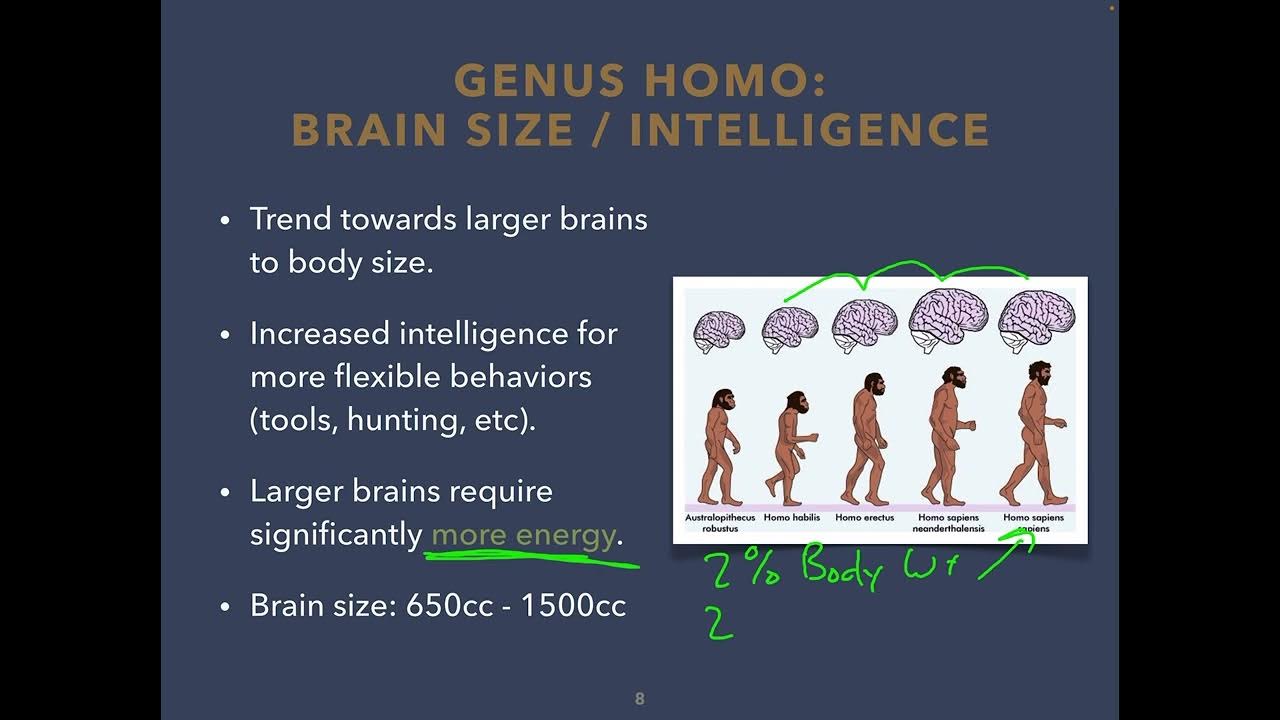Module 11.2
Summary
TLDRThe video explores *Homo habilis*, the earliest species of the genus *Homo*, known for its association with the first stone tools. Living nearly 3 million years ago in Africa, *Homo habilis* was more gracile than contemporaries like *Australopithecines* but had a larger brain (650 cubic cm) that facilitated tool use. These tools helped in scavenging meat and processing tough plant foods. The video also addresses challenges in classifying fossils due to incomplete records, with debate surrounding whether some fossils belong to *Homo habilis* or another species, like *Homo rudolfensis*. Overall, it highlights the significance of *Homo habilis* in early human evolution.
Takeaways
- 😀 *Homo habilis* is considered the earliest known species within the genus *Homo*, living around 3 million years ago.
- 😀 Fossils of *Homo habilis* have only been found in Africa, indicating their geographical range was limited to this continent.
- 😀 *Homo habilis* is often called the 'handyman' due to their use of early stone tools, which were likely improvised for survival.
- 😀 Compared to other hominins like the australopithecines, *Homo habilis* had smaller, more gracile features, including smaller teeth and jaws.
- 😀 *Homo habilis* had an enlarged brain (around 650 cubic cm), a significant increase compared to their australopithecine relatives.
- 😀 This species was fully bipedal, meaning they walked upright, but their body proportions were still somewhat primitive with shorter legs and longer arms.
- 😀 The use of tools by *Homo habilis* marks a major evolutionary advancement, likely aiding in tasks such as scavenging, meat cutting, and accessing bone marrow.
- 😀 The stone tools associated with *Homo habilis* (Oldowan tools) are simple and unstandardized, typically created opportunistically rather than through careful planning.
- 😀 *Homo habilis* existed for over a million and a half years, living in diverse environments, predominantly open grasslands in Eastern and Southern Africa.
- 😀 There is ongoing debate regarding whether the fossils of *Homo habilis* represent multiple species due to significant variation observed in fossil records, with *Homo rudolfensis* sometimes considered a separate species.
- 😀 The challenges in species classification arise from the incomplete fossil record and the difficulty in determining the exact relationships and distinctions between closely related species.
Q & A
What is Homo habilis known for and why is it nicknamed 'Handyman'?
-Homo habilis is the earliest known species in the genus Homo, dating back almost 3 million years. It is nicknamed 'Handyman' due to its ability to make and use stone tools, a key factor that likely contributed to its survival and evolution.
How does Homo habilis compare physically to other hominins, like robust australopithecines?
-Homo habilis is much more gracile than robust australopithecines. It has smaller teeth, smaller faces, and smaller bodies, with less robust jawbones and chewing muscles.
What is the significance of Homo habilis's brain size?
-Homo habilis had a brain size of approximately 650 cubic centimeters, larger than that of contemporaneous hominins like australopithecines, which had brain sizes around 500 cubic centimeters. This increase in brain size is associated with greater intelligence and the ability to create and use tools.
Was Homo habilis fully bipedal, and how did its body proportions compare to modern humans?
-Yes, Homo habilis was fully bipedal, walking upright like modern humans. However, their body proportions were still somewhat primitive, with shorter legs and longer arms compared to modern humans.
How did Homo habilis use stone tools, and what types of tools did they create?
-Homo habilis likely used stone tools such as Oldowan tools. These tools were simple, crude, and improvised, often made on the spot to meet immediate needs such as scraping meat off carcasses or breaking open bones to access marrow.
Why were stone tools important for Homo habilis's survival?
-Stone tools provided Homo habilis with several survival advantages, including the ability to scavenge meat from carcasses, break open bones to access nutrient-rich marrow, and process tough plant materials, making digestion easier and conserving energy for the brain.
Where have fossils of Homo habilis been found, and what does this tell us about their range?
-Fossils of Homo habilis have only been found in Africa, specifically in eastern and southern Africa. This geographic distribution suggests that Homo habilis lived primarily in warm, dry, open grassland environments.
What challenges do scientists face when studying Homo habilis fossils?
-One of the main challenges is the incompleteness of the fossil record. With only a few fossils available, it's difficult to definitively determine whether differences between fossils represent variation within Homo habilis or indicate different species entirely.
How does Homo habilis relate to Homo rudolfensis, and why is there debate about their classification?
-Homo habilis and Homo rudolfensis coexisted and share many similarities, but Homo rudolfensis is generally larger, more robust, and has a larger brain. The debate arises because it's difficult to determine if the differences between the two represent distinct species or just variations within the same species due to the limited fossil evidence.
What are some limitations of using fossils to study human evolution, particularly for species like Homo habilis?
-Fossils are often incomplete, and not all organisms become fossilized. Additionally, the few fossils we do find may not capture the full variation within a species, making it hard to definitively classify them as a single species or multiple species. These limitations complicate our understanding of human evolution.
Outlines

Cette section est réservée aux utilisateurs payants. Améliorez votre compte pour accéder à cette section.
Améliorer maintenantMindmap

Cette section est réservée aux utilisateurs payants. Améliorez votre compte pour accéder à cette section.
Améliorer maintenantKeywords

Cette section est réservée aux utilisateurs payants. Améliorez votre compte pour accéder à cette section.
Améliorer maintenantHighlights

Cette section est réservée aux utilisateurs payants. Améliorez votre compte pour accéder à cette section.
Améliorer maintenantTranscripts

Cette section est réservée aux utilisateurs payants. Améliorez votre compte pour accéder à cette section.
Améliorer maintenant5.0 / 5 (0 votes)






